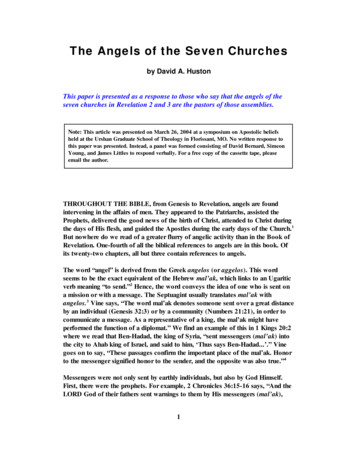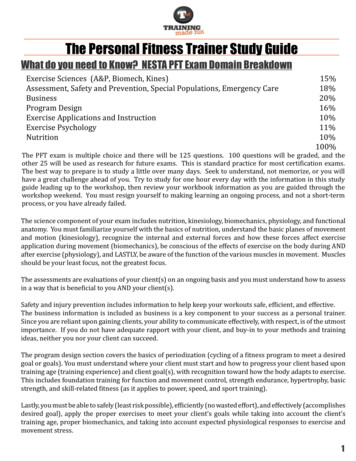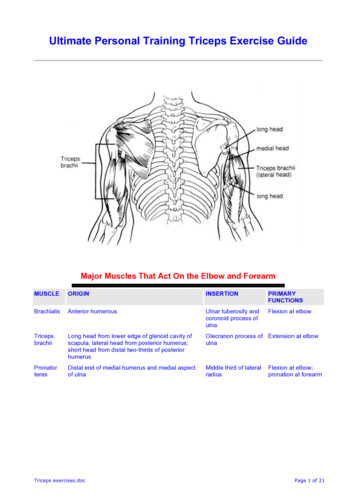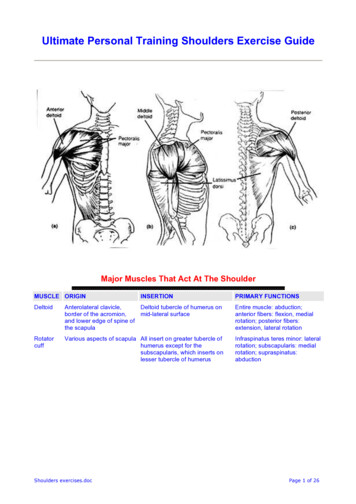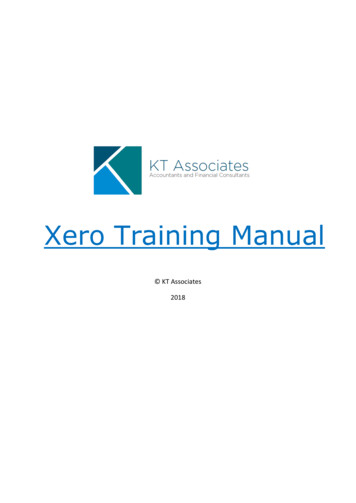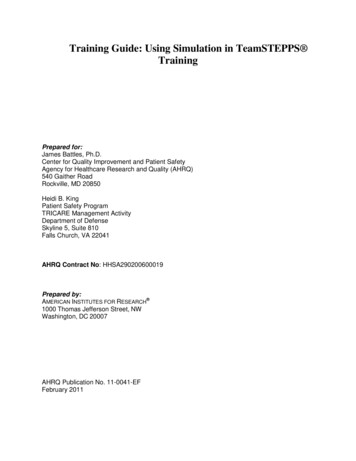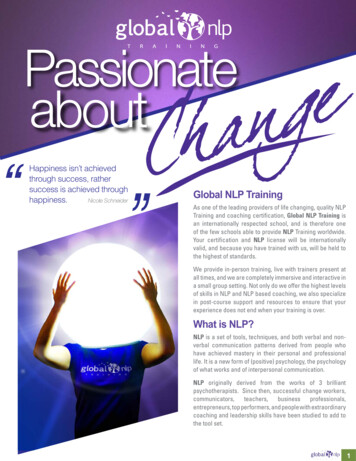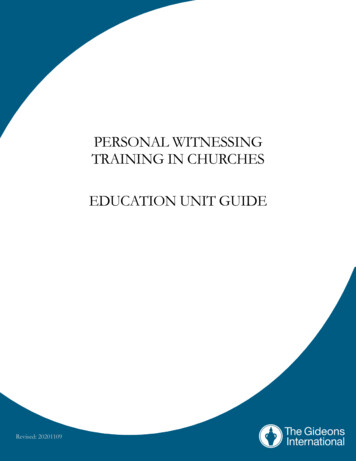
Transcription
PERSONAL WITNESSINGTRAINING IN CHURCHESEDUCATION UNIT GUIDERevised: 20201109
ContentsAbout The Gideons International . 1How to Use This Guide . 2Course Prework . 5Welcome / Objectives / Open in Prayer / Class Norms . 6Why is Personal Witnessing Important? . 13Roles, Responsibilities, and Expectations. 16Conversations: a Simple Approach to Sharing the Gospel Complete Workshop Delivery . 20Facilitator Resources . 21Promoting the Workshop. 24Evaluating Training Location and Class Size . 27Setting Up to Conduct the Workshop . 33Making the Connection . 39Workshop Follow-up . 43Day One Review and Wrap . 46Basic Facilitation Skills . 48Facilitating Discussions . 59Facilitating Break-Out Sessions . 61Facilitating Role Play Activities . 64Workshop Teach-Back Activity . 69Session Wrap / Close in Prayer . 72Train the Trainer Supporting Materials . 75Recommended Trainer Toolkit:. 76
Train the Trainer AgendaDay 17.5 hrs.Day 28 hrs.ModuleWelcome / Objectives / Open in Prayer / Class NormsWhy is Personal Witnessing Important?Roles, Responsibilities, and ExpectationsBreakPersonal Witnessing Workshop DeliveryLunchFacilitator ResourcesPromoting the WorkshopBreakEvaluating Training Location and Class SizeSetting Up to Conduct the WorkshopMaking the ConnectionWorkshop Follow UpDay 1 Review and WrapFacilitation Basics – Sage on the Stage, or Guide on the Side?Facilitating DiscussionsFacilitating Break Out SessionsBreakFacilitating Role Play ActivitiesLunchWorkshop Teach-Back ActivityBreakWorkshop Teach-Back Activity (Continued)Session Wrap / Close in 15301201512015
About The Gideons International“Go therefore and make disciples of all nations ” Matthew 28:19 (ESV)The Gideons International is an Association of Christian business and professional men and their wives dedicated totelling people about Jesus through associating together for service, sharing personal testimony, and by providingBibles and New Testaments. While we are often recognized for our work with hotels, we also place and distributeScriptures in strategic locations so they are available to those who want them, as well as to those who may not knowthey need them.The Gideons International was established in 1899. Our founders realized that Christian men needed to be continuallystrengthened in their walk with the Lord and that by standing together in faith, they could accomplish great things forGod’s Kingdom. Those formative years focused on who a man was before God and the strength and power of hispersonal testimony. Through associating together for service, Gideons challenge each other to strengthen theirtestimonies for Christ and fulfill their God-given responsibilities as spiritual leaders in their homes and churches.Members of The Gideons International share our faith because we realize how often people today need someone tocome alongside them in finding their way to true salvation that is available only through the grace of God. Asopportunities arise, we take time to share the Gospel message with friends and family, business acquaintances, andother people we meet who are struggling in their daily lives.Personal witnessing and the sharing of God’s Word has always been a unique focus of The Gideons. It’s a spiritualgift that is made stronger as Gideons participate in the activities of the ministry, such as Bible placements, Scriptureblitzes, and divine encounters where God’s Word is shared. The workshop that you are being trained to deliver[Conversations: A Simple Approach to Sharing the Gospel] is being offered to local churches as an exciting new componentof our partnership in ministry as we strive side by side for the faith of the Gospel. It’s an opportunity to build up ourbrothers and sisters in Christ by encouraging and sharing what is for us an area of strength. Through this workshop,we’ll offer a simple and straightforward approach that will help attendees be obedient to the urging of the Holy Spiritand to share the Good News of the Gospel with someone that does not know Jesus Christ as Lord and Savior.For more information, visit Gideons.orgNotes:1
How to Use This GuideThis section provides information for the Educational Unit on how to use this train the trainer guide. It will help youprepare carefully and prayerfully selected instructor candidates for commissioning. Upon completion of theircommissioning, the successful candidate will serve as an instructor, prepared to facilitate personal witnessingworkshops in churches, called Conversations: A Simple Approach to Sharing the Gospel.Note: The workshop offered in the churches will be referred to as Conversations: A Simple Approach to Sharing the Gospel(or Conversations for short), while the overall initiative uses the working title of Personal Witnessing Training inChurches.Icons:A consistent set of icons will be used throughout this trainer guide to help quickly identify information that isimportant to the delivery of the train the trainer. Each of the icons is identified below by name and is accompanied bya description of how that icon will be used in this guide.IconNotes:2NameDescriptionBiblical ReferenceThis icon will be used to identify when Bible verses andBiblical references are included within the section.Suggested TimingThis icon will be used where suggested timing for a section oractivity is provided.Direct InstructionThis icon is used to identify training content that is to bedelivered by direct instruction. Typically, this method ofdelivery is used when the content being trained is notsomething the learners are familiar with nor would be able tofigure out without help.Solicit ResponsesThis icon is used to identify where learners should besolicited for their input, opinion, feedback, etc.Capture on Easel orWhiteboardThis icon is used to identify where an easel chart or whiteboard should be used to capture responses or feedback.Show SlideThis icon is used to identify when a slide is to be displayedfor the learners.
IconNameDescriptionFacilitator HelpsThis icon is used to identify additional information providedfor the instructor that may be useful in facilitating theassociated content.Play MediaThis icon is used to identify where specific media files shouldbe played.Handout / ChecklistThis icon is used to identify where a checklist or handout isto be provided to the learners.Class DiscussionThis icon is used to identify where classroom discussions arerecommended to promote learner engagement and encouragelearners to share their experience or knowledge.Small-Group DiscussionThis icon is used to identify where small group discussionsoccur during training. Smaller groups often encourage morereserved learners to participate and engage in the learningactivity.Role Play ActivityThis icon is used to identify where role-play activities are usedin the workshop to allow learners to practice what they’velearned in the safety of a small group setting.Group ActivityThis icon is used to identify where the class is arranged insmall groups to conduct a particular activity. Typically, onemember of each small group will be asked to report out onthe group’s results.Teach Back ActivityThis icon is used to identify where a learner teach-backactivity is used.Online ActivityThis icon is used to identify where optional online activitiesare provided to replace or enhance specified content if thehost site can support the conditions needed to conduct theactivity.Refer to Instructor’s GuideThis icon is used to identify where the EU leader should refertrainers to a particular page or section of their workbook.Notes:3
Module CompositionEach module will follow a consistent approach to presenting the information relevant to the topic. Notes:4Module TitleTiming – Provides the suggested timing for the section.Introduction – High-level information for the Educational Unit about the topic in the train the trainerprogram.Learning and Performance Objectiveso Workshop Objectives – This section presents what we planned for participants to learn.o Personal Objectives – This section reminds us to find out what our participants expect to learn.Topic – This section contains the content provided to help the Educational Unit achieve the objectives.Activities: These are provided to allow for a more interactive workshop and may include activities that allowgroup participation, provide reinforcement of learning, or demonstrate mastery of the content.o Online Activity When Technology Allows – While the core train the trainer workshop requires onlylimited technology, there may be opportunities to incorporate additional content that can replace orenhance core content when the host location supports the technology requirements.o Group Discussiono Role Play Activityo Teach Back ActivityTransition – Each topic should build on or complement the next one. A smooth transition between topicshelps learners see the progression of content within the program as a single seamless presentation.
Course PreworkOne Month Before the Train the TrainerInstructor candidates will be required to review and be familiar with the courseware for the workshop.Send the welcome message to all Instructor candidates. It will provide candidates with directions on how to accesscourse materials. They will be asked to complete the prework highlighted below before the Train the Trainerworkshop.Instructor candidates will also be asked to select 30 minutes of content from the workshop for delivery during theteach-back activity near the end of the Train the Trainer workshop.This Train the Trainer session has been developed assuming that instructor candidates are familiar with the contentsof the workshop and have completed all requested prework.Expected Trainer Candidate Preparation120 – 180 minutes (prior to workshop)Prior to the Train the Trainer workshop, instructor candidates are expected to complete the following prework.1. Review the workshop training materials. (45 min.) Materials to review in advance include: Conversations: A Simple Approach to Sharing the Gospel Participant GuideConversations: A Simple Approach to Sharing the Gospel Presentation2. Select a 30-minute segment to present as a teach back during the Train the Trainer workshop that containsinformation to present and an activity to facilitate. (15 min.)3. Complete the following online modules: Basic Facilitation Skills (60 min.)Presentation Pointers – Laptop to HDTV using HDMI (10 min.)Presentation Pointers – Laptop to Projector (10 min.)Presentation Pointers – Using MiraCast with a Laptop (10 min.)Presentation Pointers – Presenting with Apple Devices (10 min.)Presentation Pointers – Presenting with Android Devices (10 min.)Presentation Pointers – Using a USB Flash Drive (10 min.)Notes:5
Welcome / Objectives / Open in Prayer / Class Norms40 minutes totalTrainer InformationSection IntroductionIt is important to create a safe, welcoming, and inviting learning environment for the workshop participants. Thetrainer sets the tone of the workshop through their actions, attitude, and approach. While many of us are familiar withand expect the traditional pedagogical model of learning, this approach may not work well everywhere. While thereare cultural differences that will require the trainer to adjust their approach to presenting the workshop, many adultlearners will prefer an approach takes into account the principles and preferences of adult learners. This section willprovide instruction, recommendations, and best practices for creating the most effective training environmentpossible.Get There EarlyTrainer InformationWhen coordinating with the host site, you should arrange for access no less than an hour before the start time of theworkshop. If extensive setup is necessary, ensure the setup occurs before the date of the workshop, or arrive earlier toallow additional time to set up. Consider seeking assistance from the host church or other members of your camp.The first order of business is to get the training environment completely set up prior to the arrival of even the mosteager attendee. As learners arrive, you don’t want to be observed by workshop attendees running around, setting up,and ignoring your participants. Tables, chairs, easel charts, white boards, name tents, projector and screen, computer,handouts, markers, activity materials, etc. must all be ready and waiting before the first participant arrives. We’ll getinto the details of setup later in this train the trainer workshop.Greet learners and introduce yourself as they arrive. Thank them for attending your workshop. Encourage them toselect a location to sit and ask them to put their name on their name tent.Notes:6
While Early Arrivals Are Waiting for the Workshop to Start 1Workshop Pre-Arrival PresentationThe time between a workshop participant’s arrival and the start of the workshop can be a great time for learners to getto know one another better. As an option for those that prefer to take their seat, have the pre-arrival slide showrunning. It will contain information about the upcoming workshop intermixed with information about The Gideons.It has no audio, so those that prefer to socialize may do so while others watch the presentation.Another option is to have name tents and markers available. Ask participants to put their name on both sides of theirname tent and write their favorite Bible verse on the inside of the name tent.Start and End on TimeTrainer InformationGideons are punctual. Start the workshop on time, and end on time. Your attendees have made a commitment for theadvertised duration of the workshop. It is better to end on time while omitting some content than to run late and keepthe workshop attendees longer than agreed.Open in PrayerUp to 5 minutes2Gideons are men of prayer. When doing the Lord’s work as part of the Gideon ministry, we seek His blessing on ourefforts. That includes this workshop. You can either open the workshop in prayer yourself or seek a volunteer fromthe workshop attendees to open in prayer. Never call out a participant to pray publicly that did not agree to do sobeforehand. Without knowing the level of comfort leading a group prayer, spiritual position or maturity of theattendees, calling on one at random is strongly discouraged.Notes:7
Personal Introductions18 minutes3It is a good idea to begin the workshop with a warm personal welcome, then give the workshop attendees anopportunity to introduce themselves to the class. Learners should share their prepared brief salvation testimony. Timepermitting, other information can be included.Some ideas for introductions include: NameBrief testimony of personal salvationTime Permitting: Home ChurchInteresting fact about meWhat I hope to get out of the workshopFavorite Bible verse (show what’s on the inside of their name tent if this option was used)History and experience as a GideonWorkshop Welcome from Gideon Headquarters2 minutesAt the designated start time, welcome the workshop participants and play the video, “Train the Trainer WorkshopWelcome from The Gideons International.” This video will welcome train the trainer workshop participants andprovide insight into the importance of including the workshop as an important component of church relations.4Train the Trainer Workshop Welcome from The Gideons International(Slide has embedded video that will start on click)Notes:8
Class Norms5 minutes5Instead of dictating the ‘rules’ of behavior for the workshop, it can be better to have a brief discussion with the classto have the class identify the expected norms of behavior for the workshop. Capture the norms on a white board oreasel paper that can be referenced during the workshop. While most of what you’d expect will probably called outanyway, it’s easier to use norms obtained through class participation later when needed since the norms were calledout and agreed upon by the participant attendees themselves. Here’s a list of expected norms that you can ‘suggest’ ifthe class has difficulty coming up with some. One person speaks at a time.Respect each other’s opinions.Come back from breaks on time.Silence or turn off mobile phones.Part of the class norms can be to agree on a break schedule. This workshopwill run for about two (2) days, and instructor candidates will be morefocused on content if they have prior knowledge of a break schedule.Typical break schedules each full training day (about 8 hrs.) would includeone break between class start and lunch, and one break between lunch andthe end of the training day. If the class wants more frequent breaks, considermaking them a bit shorter.Trainer TipOffer one 5-minute“Emergency Break” for eachday of the workshop thatany participant can call atany time. This empowers alllearners with a sharedopportunity to take a breakoutside of scheduled breaktimes.Learning and Performance Objectives10 minutes53This topic will be used to clearly state the objectives for and approximate timing of the Train the Trainer session. Inaddition to the stated objectives, learners will be encouraged to share their personal objectives and expectations forthe session. There will be instructions in the trainer guide for conducting the facilitated discussion, and a placeholderslide for this trainer-led topic.Notes:9
Direct learners to the learning objectives page in their participant workbooks. There are two (2) sets of learningobjectives that we’re concerned with. The first is the workshop objectives and the second is the learner’s expectations.EU Instructor Training Workshop Objectives53The following section identifies the goals and objectives of the Train the Trainer in the sequence as they will bedelivered. The recommended order to address the goals in the Train the Trainer program is as follows:1.2.3.4.Describe the goals and content of the workshop.State the roles and responsibilities of qualified workshop facilitators.Demonstrate the ability to promote the workshop to leaders of churches.Perform administrative, preparatory, and follow-up tasks associated with conducting both the Trainthe Trainer and the workshop.5. Demonstrate the foundational tasks associated with classroom control and facilitation.6. Demonstrate the ability to facilitate all of the activity types included in the workshop.7. Train volunteer instructor candidates to facilitate the workshop.8. Create a community of qualified trainers that can support each other in the delivery of the workshop.Describe the goals and content of the workshop.Instructor candidates need a clear understanding of the content that they will be facilitating. Instructor candidates willreceive and review the workshop materials as prework for the Train the Trainer and select one topic and one activityto present during teach-backs.State the roles and responsibilities of qualified workshop facilitators.This goal is presented at the front of the Train the Trainer session so that Instructor candidates understand thecommitment associated with becoming a workshop facilitator. The Gideons International is committed to providing ahigh-quality workshop for participating churches. Instructor candidates need to understand that they will berepresenting The Gideons International as workshop facilitators A clear understanding of the commitment,expectations, and responsibilities is necessary before candidates agree to continue with the workshop.Demonstrate the ability to promote the workshop to leaders of churches.Once trained, instructors will be required to promote the workshop within the membership of The GideonsInternational. This is necessary so that members understand what the workshop is, who it may be offered to, and whyit is being offered. This may include communication through newsletters, email, or conducting an informationalpresentation at local camp meetings. Once they have this information, members of Gideon camps will be able toinclude the availability of the workshop during discussions with local church leadership as the opportunity arises, andthen coordinate with qualified workshop trainers in their area to conduct workshop sessions at the host churches.This is positioned up front to continue to educate the learner about the scope of the responsibilities associated withthe role.Notes:10
Perform administrative, preparatory, and follow-up tasks associated with conducting both the Train the Trainer and the workshop.Workshop facilitators will need to be able to perform a variety of administrative tasks in addition to facilitating theworkshop. These tasks include evaluating the facilities offered for the workshop to determine if they meet minimumrequirements. Assuming the space is acceptable, maximum class size will need to be set to prevent overcrowding theroom. Additional duties include enrollment management and follow up recordkeeping. This item is positioned at thislocation since it is similar in scope to the other administrative tasks discussed earlier.Demonstrate the foundational tasks associated with classroom control and facilitation.This component is going to be lengthy and will take a considerable percentage of the total time for the workshop.Those selected volunteers are most likely not professional facilitators and will need to learn the basics of facilitation inorder to be successful in conducting a quality workshop. This section is positioned to include a break between trainingdays in the middle of this topic so learners can reflect on the content presented in the overnight break between dayone and day two.Demonstrate the ability to facilitate all of the activity types included in the workshop.While many of our volunteers may have participated in the types of training activities included in the workshop, theyhave most likely never facilitated one. This module builds on the basic of facilitation and therefore must be presentedafter that content. The activity types presented here include facilitation of classroom discussion, role play activities,breakout sessions, and for the Train the Trainer only, teach-backs. Instructor candidates will have the opportunity topractice facilitating a classroom activity in the safe environment of the Train the Trainer, while receiving supportivefeedback from their peers.Train volunteer Instructor candidates to facilitate the workshop.This goal is validated by the successful teach-back presented by each learner. Since successful validation cannot occuruntil all of the session’s material has been presented, and the learner has demonstrated his ability, this item ispositioned near the end of the session. Successful completion of the teach-back activity is required for the learner tobe a commissioned as a workshop presenter.Create a community of qualified instructors that can support each other in the delivery of the workshop.Instructors that complete the Train the Trainer, and graduate as commissioned workshop presenters, will be added tothe Conversations workshop facilitator community. Names and contact information of qualified facilitators will be madeavailable to the community so that the members can reach out to each other for mutual support, feedback, andassistance as needed. This community’s contact information can also be used to communicate initiative updates andrevisions. This goal is necessarily positioned last since only commissioned instructors will be added to the community.Notes:11
Personal Objectives3Have learners share and list their personal objectives. Learners should capturetheir personal objectives in the space provided in their participant guides.TransitionSay: We’ve done a good job setting the stage for a great workshop. Let’s dig inand get started!Notes:12Trainer TipAnother best practice is tohave the learners capturetheir objective on a stickynote and stick them to aneasel page titled PersonalObjectives that is posted forreview at the end of theworkshop.
Why is Personal Witnessing Important?20 minutesIntroduction6-124The intent of making this topic first is to start the session with an activity that will reinforce the importance ofpersonal witnessing. It is a commandment from Jesus Christ to all Christians, and every encounter between aChristian and a non-Christian is an opportunity for the Christian to share their faith and have an eternal impact on thesoul of the non-Christian individual. This topic will be conducted as a break-out activity with report outs from eachgroup. Each group will be assigned a persona of a typical person the group might encounter during their day. Thegroups will answer questions about why they would or would not introduce that person to Jesus, and about what theconversation might sound like.Show the topic slide and direct learners to the instruction page in their participant guide. Facilitate the activity asinstructed below. This topic will be facilitated as a small group discussion with report outs from the groups. You havethree (3) minutes to provide instructions and get the groups working.Small Group Discussion ActivityWhy is Personal Witnessing Important?1. Divide the Instructor candidates into groups of about three (3). This is the first instance of breaking thelearners into groups. Select a method from the Trainer Tips provided in the Facilitating Break-Out Sessionssection of the Instructor’s Guide and call out, as you break the learners up into groups that you are going tobe using a variety of methods thorough out the train the trainer.2. Provide each group with a “persona” handout.3. Have each group answer the following questions (presented on the current slide) and document the answersin their participant guides.a. Why is personal witnessing important?b. Where in the Bible does Jesus command his followers to personally witness?c. Would you witness to your assigned persona? Why or why not?4. Allow eight (8) minutes for the small groups to discuss and answer the questions.5. At the end of the allotted time, have the learners stop discussing in their groups.Notes:13
Group Report OutsEach group will have up to three (3) minutes to report out on their answers to the questions.1.2.3.4.5.Progress the presentation to the first persona.Have the group assigned to that persona report out on their answers to the three (3) questions presented.Allow group discussion of the response up to the allotted time.Provide positive reinforcement to the group for their thoughtful responses.Capture the Bible verses on an easel chart to post in the classroom as a reminder of the Biblical mandate tobe a personal witness for Jesus Christ.6. Progress to the next persona and repeat the steps above until all groups have reported out.Bible Verses Referencing Personal WitnessingBible verses referencing personal witnessing.Here are a few Bible references to personal witnessing (KJV):Notes:14Verse ReferenceMark 16:15-16Verse TextAnd he said unto them, Go ye into all the world, and preach the gospel to every creature.1 Peter 3:15But sanctify the Lord God in your hearts: and [be] ready always to [give] an answer toevery man that asketh you a reason of the hope that is in you with meekness and fear:Romans 10:14How then shall they call on him in whom they have not believed? and how shall theybelieve in him of whom they have not heard? and how shall they hear without a preacher?Matthew 28:19-20Go ye therefore, and teach all nations, baptizing them in the name of the Father, and ofthe Son, and of the Holy Ghost
TransitionSay: Jesus is telling us all over the Bible that personal witnessing is a very important part of being a Christian. Theworkshop we’re l
blitzes, and divine encounters where God’s Word is shared. The workshop that you are being trained to deliver [Conversations: A Simple Approach to Sharing the Gospel] is being offered to local churches as an exciting new component of our partnership in minist


